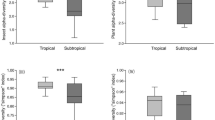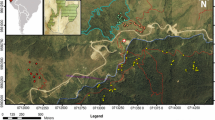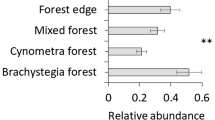Abstract
Species diversity, host specificity and species turnover among phytophagous beetles were studied in the canopy of two tropical lowland forests in Panama with the use of canopy cranes. A sharp rainfall gradient occurs between the two sites located 80 km apart. The wetter forest is located in San Lorenzo Protected Area on the Caribbean side of the isthmus, and the drier forest is a part of the Parque Natural Metropolitano close to Panama City on the Pacific slope. Host specificity was measured as effective specialization and recorded by probability methods based on abundance categories and feeding records from a total of 102 species of trees and lianas equally distributed between the two sites. The total material collected included more than 65,000 beetles of 2462 species, of which 306 species were shared between the two sites. The wet forest was 37% more species rich than the dry forest due to more saproxylic species and flower visitors. Saproxylic species and flower visitors were also more host-specific in the wet forest. Leaf chewers showed similar levels of species richness and host specificity in both forests. The effective number of specialized species per plant species was higher in the wet forest. Higher levels of local alpha- and beta-diversity as well as host specificity based on present data from a tropical wet forest, suggests higher number of species at regional levels, a result that may have consequences for ecological estimates of global species richness.
Similar content being viewed by others
Abbreviations
- PNM:
-
Parque Natural Metropolitano, Panama Province, Panama
- SLA:
-
San Lorenzo Protected Area, Colon Province, Panama
References
M.A. Alonzo-Zarazaga C.H.C. Lyal (1999) A world catalogue of families and genera of Curculionoidea (Insecta: Coleoptera) (Excepting Scolytidae and Platypodidae) Entomopraxis, S.C.P Barcelona
D.A. Andow (1991) ArticleTitleVegetational diversity and arthropod population response Annu Rev. Entomol. 36 561–586 Occurrence Handle10.1146/annurev.en.36.010191.003021
R. Barlett J. Pickering I. Gauld D. Windsor (1999) ArticleTitleEstimating global biodiversity: tropical beetles and wasps send different signals Ecol. Entomol. 24 118–121
Y. Basset (1992) ArticleTitleHost specificity of arboreal and free-living insect herbivores in rain forests Biol. J. Linnean Soc. 47 115–133
Y. Basset (2001) ArticleTitleInvertebrates in the canopy of tropical rain forests. How much do we really know? Plant Ecol. 153 87–107 Occurrence Handle10.1023/A:1017581406101
Y. Basset J.F. Mavoungou J.B. Mikissa O. Missa S.E. Miller R.L. Kitching A. Alonso (2004) ArticleTitleDiscriminatory power of different arthropod data sets for the biological monitoring of anthropogenic disturbance in tropical forests Biodivers. Conserv. 13 709–732 Occurrence Handle10.1023/B:BIOC.0000011722.44714.a4
Y. Basset V. Novotny S.E. Miller R.L. Kitching (Eds) (2003) Arthropods of Tropical Forests. Spatio-temporal Dynamics and Resource Use in the Canopy Cambridge University Press Cambridge
Y. Basset G.A. Samuelson A. Allison S.E. Miller (1996) ArticleTitleHow many species of host-specific insects feed on a species of tropical tree Biol. J. Linnean Soc. 59 201–216
E.A. Bernays R.F. Chapman (1994) Host-plant Selection by Phytophagous Insects Chapman and Hall New York
G. Brehm J. Homeier K. Fiedler (2003) ArticleTitleBeta diversity of geometrid moths (Lepidoptera: Geometridae) in an Andean montane rainforest Divers. Distrib. 9 351–366 Occurrence Handle10.1046/j.1472-4642.2003.00023.x
E. Broadhead H. Wolda (1985) ArticleTitleThe diversity of Psocoptera in two tropical forests in Panama J. Animal Ecol. 54 739–754
A. Chao W.-H. Hwang Y.-C. Chen C.Y. Kuo (2000) ArticleTitleEstimating the number of shared species in two communities Stat. Sinica. 10 227–246
B.D. Coleman (1981) ArticleTitleOn the random placement and species–area relations Math. Biosci. 54 191–215 Occurrence Handle10.1016/0025-5564(81)90086-9
P.D. Coley (1983) ArticleTitleHerbivory and defensive characteristics of tree species in a lowland tropical forest Ecol. Monogr. 53 209–233
P.D. Coley J.P. Bryant F.S. Chapin (1985) ArticleTitleResource availability and plant antiherbivore defence Science 230 895–899
J. Colville M.D. Picker R.M. Cowling (2002) ArticleTitleSpecies turnover of monkey beetles (Scarabaeidae: Hopliini) along environmental and disturbance gradients in the Namaqualand region of the succulent Karoo, South Africa Biodivers. Conserv. 11 243–264 Occurrence Handle10.1023/A:1014520226989
Colwell R.K. 1997. Estimates: statistical estimation of species richness and shared species from samples. Version 5. User’s guide and application published at: http://viceroy.eeb.uconn.edu/estimates.
R.K. Colwell J.A. Coddington (1994) ArticleTitleEstimating terrestrial biodiversity through extrapolation Philos. Trans. Roy. Soc. Lond. B 345 101–118 Occurrence Handle1:STN:280:ByqD283ls1I%3D
R.K. Colwell D.J. Futuyma (1971) ArticleTitleOn the measurement of niche breadth and overlap Ecology 52 567–576
R. Condit P.S. Ashton P. Baker S. Bunyavejchewin S. Gunatilleke N. Gunatilleke S.P. Hubbell R.B. Foster A. Itoh J.V. LaFrankie H.S. Lee E. Losos N. Manokaran R. Sukumar T. Yamakura (2000) ArticleTitleSpatial patterns in the distribution of tropical tree species Science 288 1414–1418 Occurrence Handle10.1126/science.288.5470.1414 Occurrence Handle10827950 Occurrence Handle1:CAS:528:DC%2BD3cXjslGkt7s%3D
R. Condit N. Pitman E.G.J. Leigh J. Chave J. Terborgh R.B. Foster P.V. Nunez S. Aguilar R. Valencia G. Villa H.C. Muller-Landau E. Losos S.P. Hubbell (2002) ArticleTitleBeta-diversity in tropical forest trees Science 295 666–669 Occurrence Handle10.1126/science.1066854 Occurrence Handle11809969 Occurrence Handle1:CAS:528:DC%2BD38XptF2ntg%3D%3D
E.F. Connor S.H. Feath D. Simberloff P.A. Opler (1980) ArticleTitleTaxonomic isolation and the accumulation of herbivorous insects: a comparison of introduced and native trees Ecol. Entomol. 5 205–211
E.F. Connor D. McCoy (1979) ArticleTitleThe statistics and biology of the species–area relationship Am. Nat. 113 791–833 Occurrence Handle10.1086/283438
P.J. DeVries (1994) Patterns of butterfly diversity and promising topics in natural history and ecology L.A. Mcdade K.S. Bawa H.A. Hespenheide G.S. Hartshorn (Eds) La Selva. Ecology and Natural History of a Neotropical Rain Forest The University of Chicago Press Chicago 187–194
R.K. Didham P.M. Hammond J.H. Lawton P. Eggleton N.E. Stork (1998) ArticleTitleBeetle species responses to tropical forest fragmentation Ecol. Monogr. 68 295–323
T.L. Erwin (1982) ArticleTitleTropical forests: their richness in Coleoptera and other arthropod species Coleopts. Bull. 36 IssueID1 74–75
T.L. Erwin (1983) Beetles and other insects of the tropical forest canopies at Manaus, Brazil, sampled with insecticidal fogging techniques S.L. Sutton T.C. Whitmore A.C. Chadwick (Eds) Tropical Rain Forest: Ecology and Management Blackwell Scientific Publications Oxford 59–75
T.L. Erwin (1991) ArticleTitleHow many species are there? Revisited. Conserv. Biol. 5 1–4 Occurrence Handle10.1111/j.1523-1739.1991.tb00145.x
A. Floren E. Linsenmair (2001) ArticleTitleThe influence of anthropogenic disturbance on the structure of arboreal arthropod communities Plant Ecol. 153 153–167 Occurrence Handle10.1023/A:1017510312462
A. Floren E. Linsenmair (2003) How do beetle assemblages respond to anthropogenic disturbance? Y. Basset R.L. Kitching S. Miller V. Novotny (Eds) Arthropods of Tropical Forests. Spatio-temporal Dynamics and Resource Use in the Canopy Cambridge University Press Cambridge 190–197
R.W. Flowers D.H. Janzen (1997) ArticleTitleFeeding records of Costa Rican leaf beetles (Coleoptera: Chrysomelidae) Florida Entomol. 80 334–366
K.J. Gaston (1991) ArticleTitleHow large is a species’ geographical range? Oikos 61 434–438
A.H. Gentry (1988) ArticleTitleChanges in plant community diversity and floristic composition on environmental and geographical gradients Ann. MO Bot. Gard. 75 1–34
J. Ghazoul (2002) ArticleTitleImpact of logging on the richness and diversity of forest butterflies in a tropical dry forest in Thailand Biodiv. Conserv. 11 521–541
H.A. Gleason (1922) ArticleTitleOn the relation between species and area Ecology 3 158–162
S.J. Grove (2002) ArticleTitleThe influence of forest management history on the integrity of the saproxylic beetle fauna in an Australian lowland tropical rainforest Biol. Conserv. 104 149–171 Occurrence Handle10.1016/S0006-3207(01)00140-9
P.M. Hammond (1992) Species inventory B. Groombridge (Eds) Global Biodiversity. Status of the Earth’s Living Resources Chapman & Hall London 17–39
I. Hanski M. Gilpin (1991) ArticleTitleMetapopulation dynamics: brief history and conceptual domain Biol. J. Linnean Soc. 42 3–16
S. Harrison S.J. Ross J.H. Lawton (1992) ArticleTitleBeta diversity on geographic gradients in Britain J. Animal Ecol. 61 151–158
H.A. Hespenheide (1994) An overview of faunal studies L.A. Mcdade K.S. Bawa H.A. Hespenheide G.S. Hartshorn (Eds) La Selva. Ecology and Natural History of a Neotropical Rain Forest The University of Chicago Press Chicago
V.H. Heywood (Eds) (1995) Global Biodiversity Assessment (GBA) UNEP, Cambridge University Press Cambridge
D.H. Janzen (1988) Tropical dry forests: the most endangered major tropical ecosystem E.O. Wilson F.M. Peter (Eds) Biodiversity National Academy Press Washington, DC 130–137
T. Jermy (1988) ArticleTitleCan predation lead to narrow food specialization in phytophagous insects? Ecology 69 902–904
J.H. Lawton D. Schröder (1977) ArticleTitleEffects of plant typesize of geographical range and taxonomic isolation on the number of insect species associated with British plants Nature 265 137–140
E.G.J. Leigh (1999) Tropical Forest Ecology. A View from Barro Colorado Island Oxford University Press New York
S.F.J. MacLean T.S. Jensen (1985) ArticleTitleFood plant selection by insect herbivores in Alaskan arctic tundra: the role of plant life form Oikos 44 211–221
A.E. Magurran (2003) Measuring Biological Diversity Blackwell Publishing Oxford
N. Mawdsley (1996) The theory and practice of estimating regional species richness from local samples D.S. Edwards W.E. Booth S.C. Choy (Eds) Tropical Rainforest Research-Current Issues Kluwer Academic Publishers Dordrecht 193–213
N.A. Mawdsley N.E. Stork (1997) Host-specificity and effective specialization of tropical canopy beetles N.E. Stork J. Adis R.K. Didham (Eds) Canopy Arthropods Chapman & Hall London 104–130
R.M. May (1990) ArticleTitleHow many species? Philos. Trans. Roy. Soc. Lond. B 330 293–304
R.M. May (1994) The effects of spatial scale on ecological questions and answers P.J. Edwards R.M. May N.R. Webb (Eds) Large-Scale Ecology and Conservation Biology Blackwell Scientific Publications Oxford 1–17
S. Neuvonen P. Niemelä (1983) ArticleTitleSpecies richness and faunal similarity of arboreal insect herbivores Oikos 40 452–459
V. Novotny Y. Basset (2000) ArticleTitleRare species in communities of tropical insect herbivores: pondering the mystery of singletons Oikos 89 564–572 Occurrence Handle10.1034/j.1600-0706.2000.890316.x
V. Novotny Y. Basset J. Auga W. Boen C. Dal P. Drozd M. Kasbal B. Isua R. Kutil M. Manumbor K. Molem (1999) ArticleTitlePredation risk for herbivorous insects on tropical vegetation: a search for enemy-free space and time Aust. J. Ecol. 24 477–483
V. Novotny Y. Basset S.E. Miller G.D. Weiblen B. Bremer L. Cizek P. Drozd (2002a) ArticleTitleLow host specificity of herbivorous insects in a tropical forest Nature 416 841–844 Occurrence Handle10.1038/416841a Occurrence Handle1:CAS:528:DC%2BD38XjtFyksb0%3D
V. Novotny Y. Basset S.E. Miller P. Drozd L. Cizek (2002b) ArticleTitleHost specialization of leaf-chewing insects in a New Guinea rainforest J. Animal Ecol. 71 400–412
V. Novotny O. Missa (2000) ArticleTitleLocal versus regional species richness in tropical insects: one lowland site compared with the island of New Guinea Ecol. Entomol. 25 445–451 Occurrence Handle10.1046/j.1365-2311.2000.00277.x
F. Ødegaard (2000a) ArticleTitleHow many species of arthropods? Erwin’s estimate revised Biol. J. Linnean Soc. 71 583–597
F. Ødegaard (2000b) ArticleTitleThe relative importance of trees versus lianas as hosts for phytophagous beetles (Coleoptera) in tropical forests J. Biogeogr. 27 283–296
F. Ødegaard (2003) Species richness, taxonomic composition and host specificity of phytophagous beetles in the canopy of a tropical dry forest in Panama Y. Basset V. Novotny S.E. Miller R.L. Kitching (Eds) Arthropods of Tropical Forests. Spatio-temporal Dynamics and Resource Use in the Canopy Cambridge University Press Cambridge 220–236
F. Ødegaard (2004) ArticleTitleSpecies richness of phytophagous beetles in the tropical tree Brosimum utile (Moraceae): the effects of sampling strategy and the problem of tourists Ecol. Entomol. 29 76–88
F. Ødegaard O.H. Diserud S. Engen K. Aagaard (2000) ArticleTitleThe magnitude of local host specificity for phytophagous insects and its implications for estimates of global species richness Conserv. Biol. 14 1182–1186
S.L. Pimm (1991) The Balance of Nature? Ecological Issues in the Conservation of Species and Communities The University of Chicago Press Chicago
P.W. Price (1992) ArticleTitleThe resource-based organization of communities Biotropica 24 273–282
P.W. Price I.R. Diniz H.C. Morais E.S.A. Marques (1995) ArticleTitleThe abundance of insect herbivore species in the tropics: the high local richness of rare species Biotropica 27 468–478
A. Redfearn S.L. Pimm (1988) ArticleTitlePopulation variability and polyphagy in herbivorous insect communities Ecol. Monogr. 58 39–55
C. Ricotta M.L. Carranza G. Avena (2002) ArticleTitleComputing beta-diversity from species area curves Basic Appl. Ecol. 3 15–18 Occurrence Handle10.1078/1439-1791-00082
D.W. Roubik (1992) Loose niches in tropical communities: why are there so many trees and so few bees? M.D. Hunter T. Ohgushi P.W. Price (Eds) Resource Distribution and Animal-Plant Interactions Academic Press San Diego, CA
D.A. Saunders J.R. Hobbs C.R. Margules (1991) ArticleTitleBiological consequences of ecosystems fragmentation: a review Conserv. Biol. 5 18–32 Occurrence Handle10.1111/j.1523-1739.1991.tb00384.x
A. Shmida M.V. Wilson (1985) ArticleTitleBiological determinants of species diversity J. Biogeogr. 12 1–20
T.R.E. Southwood (1960) ArticleTitleThe abundance of the Hawaiian trees and the number of their associated insect species Proc. Hawaiian Entomol. Soc. 17 299–303
T.R.E. Southwood (1961) ArticleTitleThe number of species of insect associated with various trees J. Animal Ecol. 30 1–8
N.E. Stork (1997) Measuring global biodiversity and its decline M.L. Reaka-Kudla D.E. Wilson E.O. Wilson (Eds) Biodiversity II Joseph Henry Press Washington, DC 41–68
D.R. Strong J.H. Lawton S.R. Southwood (1984) Insects on Plants Harvard University Press Cambridge, MA
R.H. Whittaker (1960) ArticleTitleVegetation of the Siskiyou Mountains, Oregon and California Ecol. Monogr. 30 279–338
H. Wolda (1978) ArticleTitleFluctuations in abundance of tropical insects Am. Nat. 112 1017–1045 Occurrence Handle10.1086/283344
H. Wolda (1980) ArticleTitleSeasonality of tropical insects I. Leafhoppers (Homoptera) in Las Cumbres, Panama J. Animal Ecol. 49 277–290
H. Wolda C.W. O’Brien H.P. Stockwell (1998) ArticleTitleWeevil diversity and seasonality in tropical Panama as deduced from light-trap catches (Coleoptera: Curculionidae) Smithsonian Contrib. Zool. 590 1–79
S.J. Wright (1992) ArticleTitleSeasonal droughtsoil fertility, and the species density of tropical forest plant communities Trends Ecol. Evol. 7 260–263 Occurrence Handle10.1016/0169-5347(92)90171-7
J. Wright M. Colley (1994) Accessing the Canopy. Assessment of Biological Diversity and Microclimate of the Tropical Forest Canopy: Phase I United Nation Environmental Program Nairobi, Kenya
S.J. Wright V. Horlyck Y. Basset H. Barrios A. Bethancourt S.A. Bohlmann G.S. Gilbert G. Goldstein E.A. Graham K. Kitajima M.T. Lerdau F.C. Meinzer F. Ødegaard D.R. Reynolds D.W. Roubik S. Sakai M. Samaniego J.P. Sparks S. Bael ParticleVan K. Winter G. Zotz (2003) Tropical Canopy Biology Program, Republic of Panama Y. Basset V. Horlyck S.J. Wright (Eds) Studying Forest Canopies from Above: The International Canopy Crane Network Smithsonian Tropical Research Institute and UNEP Panama 137–155
Author information
Authors and Affiliations
Corresponding author
Rights and permissions
About this article
Cite this article
Ødegaard, F. Host Specificity, Alpha- and Beta-Diversity of Phytophagous Beetles in Two Tropical Forests in Panama. Biodivers Conserv 15, 83–105 (2006). https://doi.org/10.1007/s10531-004-3106-5
Received:
Accepted:
Issue Date:
DOI: https://doi.org/10.1007/s10531-004-3106-5




